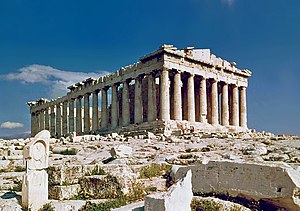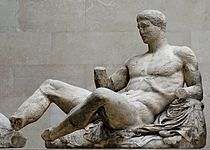Parthenoi
| Parthenon | |
|---|---|
| Παρθενώνας | |

The Parthenon
|
|
| General information | |
| Type | Temple |
| Architectural style | Classical |
| Location | Athens, Greece |
| Construction started | 447 BC |
| Completed | 432 BC |
| Destroyed | Partially on 26 September 1687 |
| Height | 13.72 m (45.0 ft) |
| Dimensions | |
| Other dimensions | Cella: 29.8 by 19.2 m (98 by 63 ft) |
| Technical details | |
| Size | 69.5 by 30.9 m (228 by 101 ft) |
| Design and construction | |
| Architect | Iktinos, Callicrates |
| Other designers | Phidias (sculptor) |
 |
|
|
|
Coordinates: 37°58′17″N 23°43′35″E / 37.9714°N 23.7265°E
The Parthenon (/ˈpɑːrθəˌnɒnˌ -nən/; Ancient Greek: ; Modern Greek: Παρθενώνας, Parthenónas) is a former temple, on the Athenian Acropolis, Greece, dedicated to the goddess Athena, whom the people of Athens considered their patron. Construction began in 447 BC when the Athenian Empire was at the peak of its power. It was completed in 438 BC although decoration of the building continued until 432 BC. It is the most important surviving building of Classical Greece, generally considered the zenith of the Doric order. Its decorative sculptures are considered some of the high points of Greek art. The Parthenon is regarded as an enduring symbol of Ancient Greece, Athenian democracy and western civilization, and one of the world's greatest cultural monuments. The Greek Ministry of Culture is currently carrying out a programme of selective restoration and reconstruction to ensure the stability of the partially ruined structure.
...
Wikipedia
